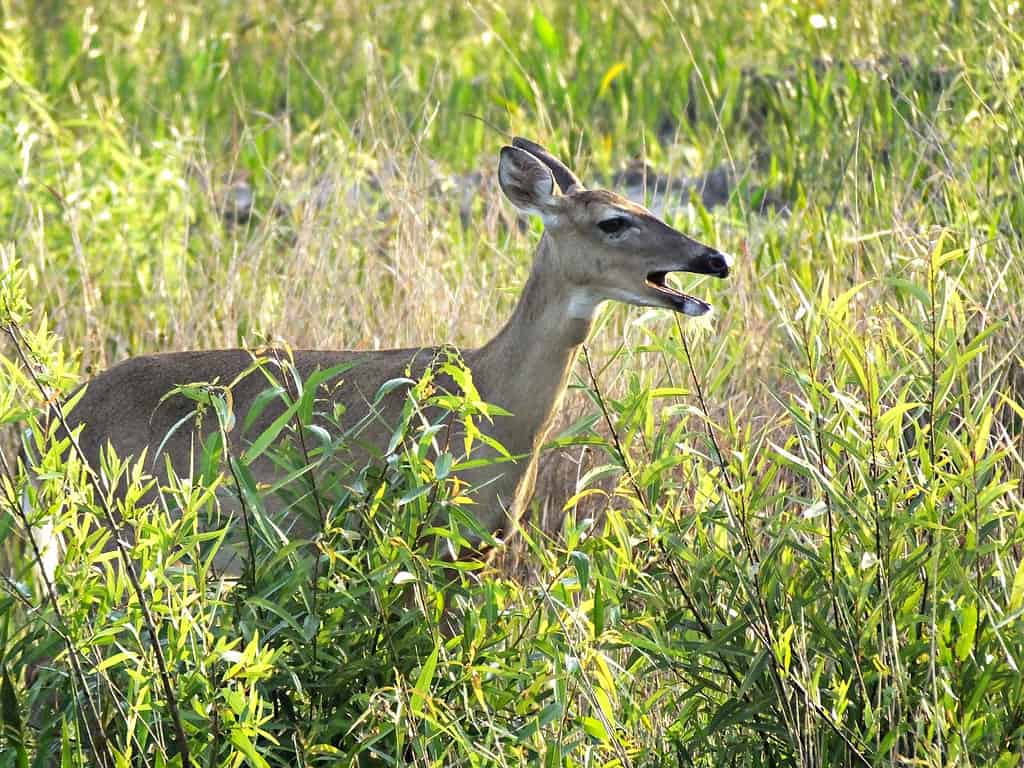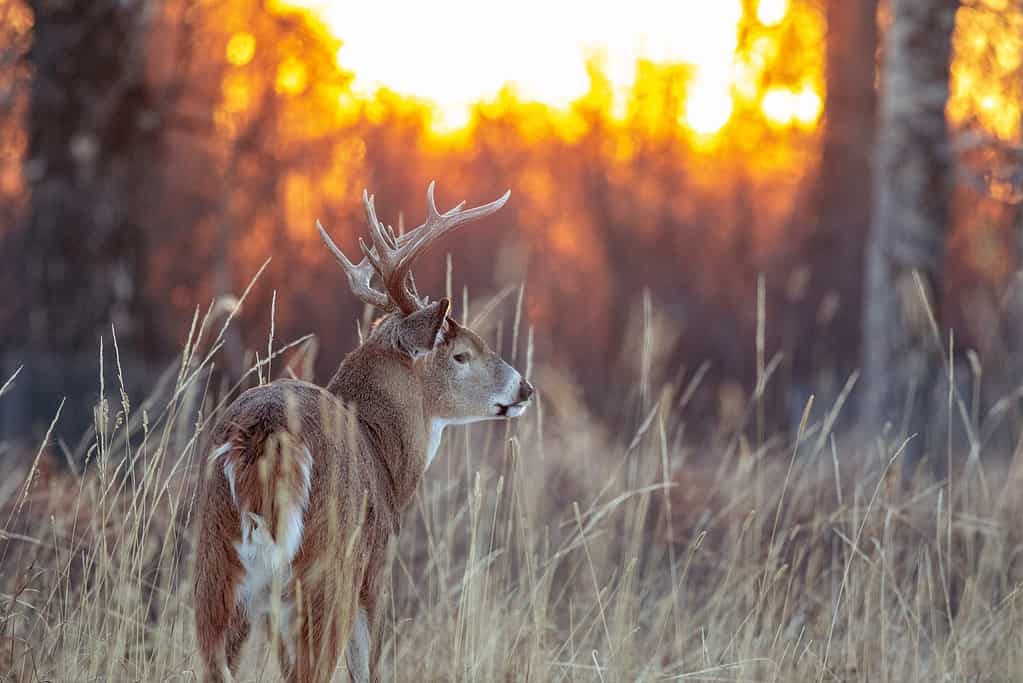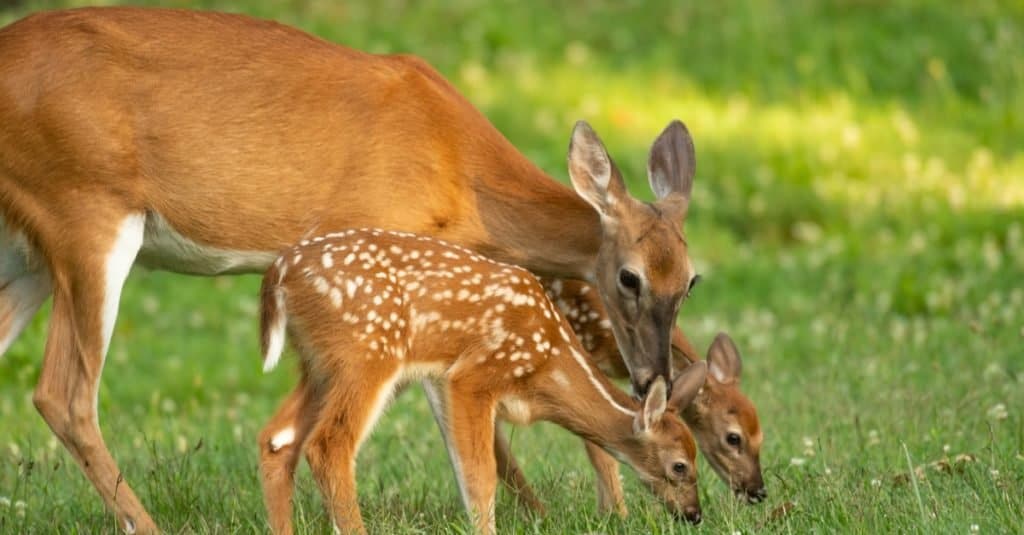Many animals in the order Artiodactyla are kept as livestock or pets, including goats, sheep, and cows. While deer share the order with these animals, you don’t usually find them kept in barns or backyards (except when they wander in on their own). Although they have many similarities, the differences between deer and barnyard Artiodactyls play a role in whether or not deer make good pets.
Can You Domesticate Deer?

White-tailed deer live in almost every habitat across North America.
©passion4nature/iStock via Getty Images
White-tailed deer (Odocoileus virginianus) can be found virtually everywhere throughout southern Canada, down through Central America, and across most of the continental United States. In fact, the only states where white-tailed deer are not commonly found are California, Nevada, and Utah. Overall, there are an estimated 30 million white-tailed deer in the United States.
With deer so prevalent, why aren’t they domesticated like other animals? The reasons go back thousands of years. While cows were domesticated approximately 10,500 years ago, the same approach was not taken with deer. This was partially because deer were commonly hunted for food, so there was no need to domesticate them. Additionally, deer do not meet the criteria for domestication, as outlined by American scientist Jared Diamond.
Diamond’s Theory of Domestication
Diamond posited that there were six factors for the successful domestication of a species. These factors include:
1. The animal’s diet: They must consume a readily available diet that easily converts plant life to meat.
2. Growth: The animal must reach mature size quickly to make it worth a farmer’s time and investment.
3. Breeding: The species can’t have problems breeding in captivity, making animals that need a lot of range and privacy for breeding poor candidates for domestication.
4. Disposition: The animals must be docile and cannot be too dangerous to domesticate.
5. Panic: The animals must not be easily stressed or panicked, nor have a strong flight response and tendency to flee when threatened.
6. Herd structure: The species must live in herds with a well-developed hierarchy and have overlapping ranges instead of exclusive territories. Except for the domestic cat, all domesticated animals belong to social hierarchies with strong leadership that result in them seeing humans as the pack leader.
White-tailed deer do not meet these requirements. Therefore, they have not been domesticated, despite humans’ ever-advancing knowledge of breeding. They simply aren’t good candidates for domestication. For an animal to be useful as livestock or pets, they need to be domesticated and see humans as being in charge.
So, Do Deer Make Good Pets?

Bucks can be particularly dangerous, especially during the fall months of rut.
©iStock.com/Wirestock
Because white-tailed deer have not been domesticated, they do not make good pets. While deer can be tamed, it is important to remember that taming differs from domestication. Although neighborhood deer may become accustomed to people, or even accept food from people’s hands, this is different than living in enforced captivity, which can be incredibly stressful.
Deer can die of stress in captivity. This is called capture myopathy. In captivity, a deer is continuously stressed by the presence of people, which deer consider a threat or predator. This stress can cause shock, and electrolyte and physiological imbalances, ultimately resulting in muscle damage and death. While some deer that are hand-raised from a young age do not suffer the extreme levels of stress as captured deer, long-term effects of stress can cause health problems in even the most seemingly relaxed deer.
Deer — and in particular, male deer (bucks)— can also be incredibly erratic, unpredictable, and moody. They can easily jump over high fences, clearing fences as tall as 8 feet with a running start. This makes it hard to contain them, often resulting in escape. Additionally, a buck’s unpredictability and aggressiveness increase during mating season or rut, when the bucks are flooded with testosterone as they search for mates. As such, it can be very dangerous to keep a buck as a pet, no matter how cute or docile it may be as a fawn.
Is it Legal to Have a Pet Deer?

Does will spend time in herds, while bucks will often form bachelor groups outside of rut.
©Amy Lutz/Shutterstock.com
The danger that deer present is one reason that many states do not legally allow people to keep deer as pets. In fact, keeping a deer as a pet is illegal in most of the United States. Having a white-tailed deer as a pet is illegal in 35 states. Eleven states will allow you to keep a deer as a pet with a proper permit, but only five states have no regulations around having a deer.
This is because deer are considered wild animals. Even in the states that do allow white-tailed deer as pets, many have regulations limiting which deer can be kept as pets. Many laws are retroactive to deer that were captured before 2012, essentially grandfathering in prior deer ownership to modern regulations.
What to Do If You Find a Fawn

Deer generally have one to two babies at a time, though triplets happen occasionally.
©Tony Campbell/Shutterstock.com
Many people find fawns alone and believe them to be abandoned. This is seldom the case. White-tailed deer leave their fawns alone to avoid attracting predators to their location. The mother returns at dusk and dawn to feed the baby but will otherwise stay away. Once the baby is a few weeks old, it will venture out from its hiding place with its mother.
This is perfectly normal deer behavior that has evolved over thousands of years. If a fawn is alone sitting quietly, it is healthy and being attended to by its mother. If a fawn is wandering around bleating or crying, this is a distress call, and it is possible that its mother has not returned. In this situation, do not approach or touch the fawn, but call a local wildlife rehabilitator to receive the next steps on how to proceed.
Additionally, you should never move a fawn, even if its location seems like a bad one. The mother knows where she left her baby, and if it is moved, she will be unable to find it. You should also never bottle-feed a fawn or attempt to give it food. Giving fawns milk from other animals can make them sick and cause harm, as their systems are unable to process it properly. Instead, leave the fawn alone and let mom do her job. This system has been successful without human intervention for the 30 million deer alive and well across the country.
The photo featured at the top of this post is © Jim Cumming/Shutterstock.com
Thank you for reading! Have some feedback for us? Contact the AZ Animals editorial team.







